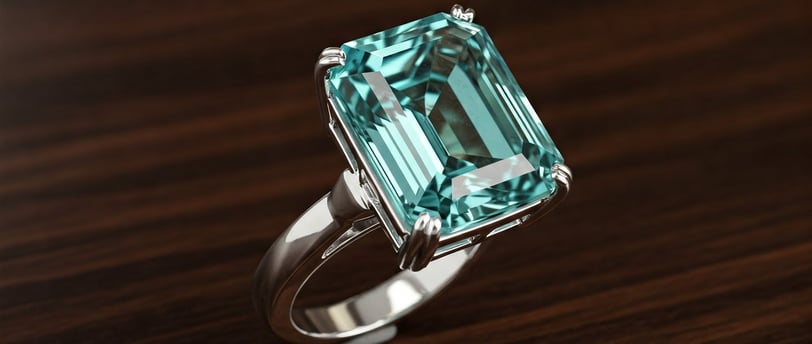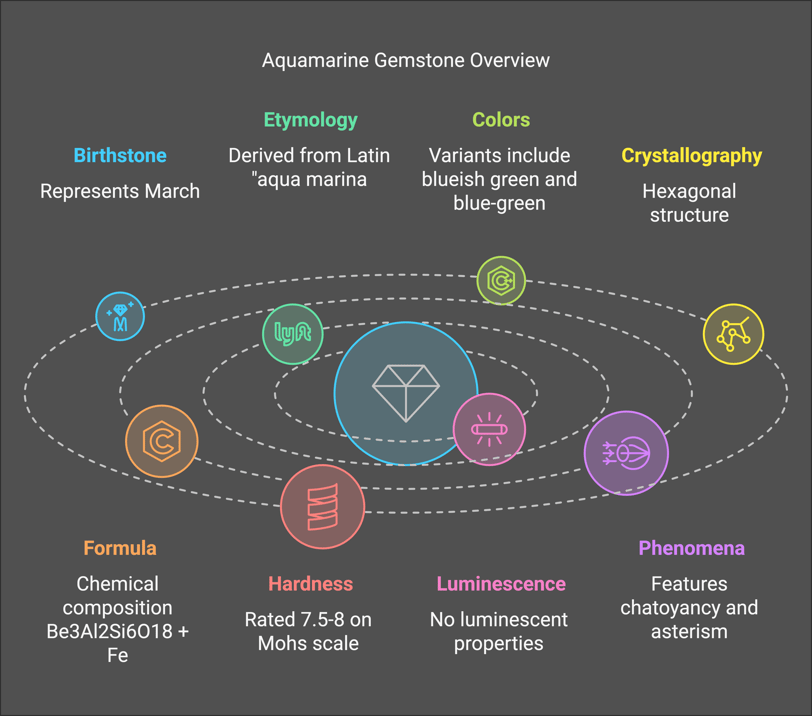Aquamarine
Explore aquamarine, the blue-green gemstone of the beryl family, renowned for its connection to the sea and its use in beautiful jewellery. Discover its unique properties and how to select the perfect stone for your collection.
1/30/20253 min read


History
Aquamarine, named after the colour of seawater, has long been associated with the sea and sailors. It's said to have originated in the treasure chests of mermaids, and was believed to protect mariners and bring good health. This gemstone is also considered to enhance the happiness of marriages. Aquamarine is the modern birthstone for March and the gem for the 19th wedding anniversary. It's a popular choice for engagement rings, jewellery, and gemstone collections. The beautiful blue to blue-green hues of aquamarine evoke a refreshing dip in a cool pool.
Mineral Origins
Aquamarine is a variety of the mineral beryl, like emerald. Its blue to blue-green colour comes from iron in the crystal. Aquamarine is found in various locations around the world, with major deposits in Brazil, Tanzania, Kenya, Mozambique, Nigeria, and Madagascar. Other sources include Russia, Sri Lanka, Pakistan, and Afghanistan. Aquamarine is formed in granitic rocks, especially granite pegmatites. The crystals can grow to be quite large, with some reaching over a foot in length.
The Four C’s
Colour
The most desirable aquamarines have a moderately strong, dark blue to slightly greenish-blue hue. Although some consumers prefer the natural sea-green colour, generally, a purer, more intense blue is more valuable. Aquamarine colours range from blueish green, blue-green, greenish blue to deep blue, and tones vary from very light to moderately dark. Heat treatment is often used to remove the yellow or green tints, leaving the stone with a more desirable blue colour.
Clarity
For faceted aquamarines, an eye-clean clarity grade is preferred (VS or VVS). Visible inclusions will lower the stone’s value. However, some aquamarines have an icy quality due to their transparency which increases their value. Included stones, with effects that make the stone look like glacial ice, have also become popular in jewellery. It is now a trend to use included, but good-colour aquamarines as unique centrepieces for jewellery, or even as partially polished crystal slices or nuggets in necklaces. In some beryl crystals, there are enough parallel inclusions to allow cutters to fashion the rough to show a cat's-eye.
Carat
Aquamarines come in a wide range of sizes, from small to very large stones. Larger stones are more likely to exhibit a darker colour. Gems under 5 carats may not display desirable tones, therefore they are more often seen as featured stones rather than accents. The price per carat does not increase exponentially with size; in fact, it tends to drop for stones over 25 carats as they become too large for jewellery.
Cut
Aquamarines are often cut to enhance their colour and brilliance. Popular cuts include emerald cuts and Barion cuts, but aquamarines can be fashioned into almost any shape. The gem’s hardness and transparency make it popular for artistic designer cuts and carvings. Gem cutters often use a 43° pavilion mains on aquamarine for the highest brilliance. Although low crown angles produce higher brilliance, higher crowns are used to deepen the colour.
Be Aware Of
Enhancements
Most aquamarines are heat-treated to remove green hues and make them bluer. This treatment is permanent and widely accepted in the jewellery industry and doesn't lower the value of the gem. The treatment does not affect tone, only the hue of the stone. It is undetectable with modern gemological equipment, so any pure blue aquamarine is usually considered to be heat-treated.
Simulants
Various materials can imitate aquamarine. Synthetic spinel, heat-treated zircon, and irradiated and heated topaz can be used as alternatives due to their blue colour. Always be aware of stones priced too cheaply for their apparent quality. A diamond tester or loupe exam can help distinguish between a topaz and aquamarine.
Synthetics
Synthetic aquamarines can be grown in labs and are difficult to distinguish from natural stones. These have essentially the same chemical, physical, and optical properties as natural aquamarines. Gemological labs can help determine if a stone is natural or synthetic.
Final Thoughts
Buying Tips
When buying an aquamarine, consider that the best stones are a marriage of colour and clarity, with a dark blue to slightly greenish-blue hue and no visible inclusions. Fine aquamarines are rare and expensive. Work with a jeweler who has expertise in aquamarines and can show you a variety of stones to compare. Trust your colour preferences, as a gem with more green may be beautiful and less costly than a pure blue one. Be aware that some aquamarines may be sold with trade names such as "Brazilian" or "Madagascar" which may refer to the colour rather than the gem's origin.
Jewellery Care
Aquamarines are durable enough for daily wear, but should be cleaned every three or four times they're worn. The safest method for at-home cleaning is warm water and gentle dish detergent, using a soft brush to scrub the stone and then air dry. Remove aquamarine jewellery before bedtime, as with other fine jewellery. Inclusions may not react well to mechanical cleaning techniques such as ultrasound or steam, increasing the risk of shattering. It is advised to consult with a gemmologist before using these methods.


Gemius Stones
Expertise
© 2025. All rights reserved.
